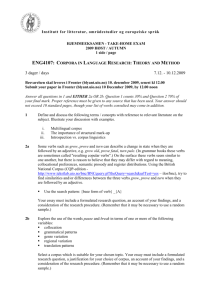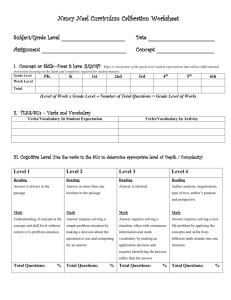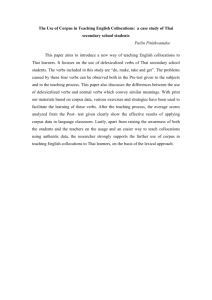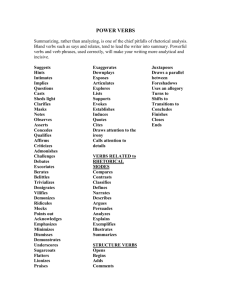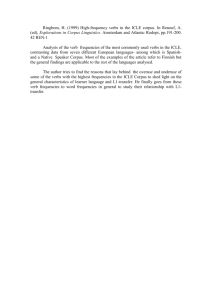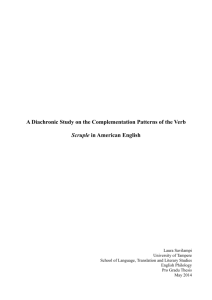eng2153.v13 - Universitetet i Oslo
advertisement
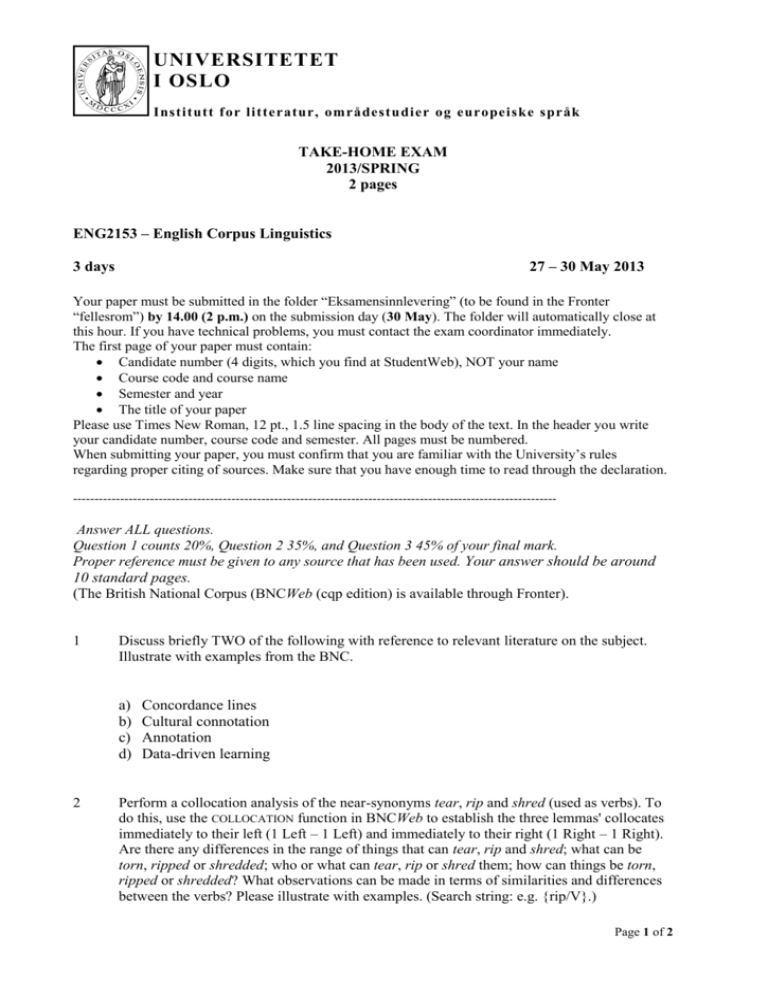
UNIVERSITETET
I OSLO
Institutt f or litteratur, områdestudier og europeiske språk
TAKE-HOME EXAM
2013/SPRING
2 pages
ENG2153 – English Corpus Linguistics
27 – 30 May 2013
3 days
Your paper must be submitted in the folder “Eksamensinnlevering” (to be found in the Fronter
“fellesrom”) by 14.00 (2 p.m.) on the submission day (30 May). The folder will automatically close at
this hour. If you have technical problems, you must contact the exam coordinator immediately.
The first page of your paper must contain:
Candidate number (4 digits, which you find at StudentWeb), NOT your name
Course code and course name
Semester and year
The title of your paper
Please use Times New Roman, 12 pt., 1.5 line spacing in the body of the text. In the header you write
your candidate number, course code and semester. All pages must be numbered.
When submitting your paper, you must confirm that you are familiar with the University’s rules
regarding proper citing of sources. Make sure that you have enough time to read through the declaration.
-----------------------------------------------------------------------------------------------------------------
Answer ALL questions.
Question 1 counts 20%, Question 2 35%, and Question 3 45% of your final mark.
Proper reference must be given to any source that has been used. Your answer should be around
10 standard pages.
(The British National Corpus (BNCWeb (cqp edition) is available through Fronter).
1
Discuss briefly TWO of the following with reference to relevant literature on the subject.
Illustrate with examples from the BNC.
a)
b)
c)
d)
2
Concordance lines
Cultural connotation
Annotation
Data-driven learning
Perform a collocation analysis of the near-synonyms tear, rip and shred (used as verbs). To
do this, use the COLLOCATION function in BNCWeb to establish the three lemmas' collocates
immediately to their left (1 Left – 1 Left) and immediately to their right (1 Right – 1 Right).
Are there any differences in the range of things that can tear, rip and shred; what can be
torn, ripped or shredded; who or what can tear, rip or shred them; how can things be torn,
ripped or shredded? What observations can be made in terms of similarities and differences
between the verbs? Please illustrate with examples. (Search string: e.g. {rip/V}.)
Page 1 of 2
3
Perform a corpus study, using BNCweb, answering questions (a)-(c) below. Your
discussion should be written as a piece of text and should include examples.
Complementation patterns
a) Use the corpus to verify the statement that the following verbs can be followed by
either a verb ending in -ing or the to-infinitive: begin, bother, claim, continue, offer,
postpone. (A possible search sting is e.g. {begin/V} *ing). Supply your answer with
examples from the corpus.
b) Consider the verbs from (a) which can take both -ing and to-infinitive
complementation. Do they have the same meaning regardless of complementation?
Which verbs do, and which verbs do not? Give examples of differences and
similarities in meaning.
c) How do the –ing vs. to-infinitive complementation patterns that you have outlined
above contribute to the concept of association between pattern and meaning of the
verbs discussed (i.e. the inseparability of grammar and lexis)?
The grades will be published within 3 weeks in StudentWeb.
For an explanation of the mark obtained, please contact the exam coordinator, Kristin Berstad
(k.m.berstad@ilos.uio.no) within one week after the exam results have been published. Remember to include
your candidate number. The examiner will decide whether to give a written or oral explanation.
Page 2 of 2
